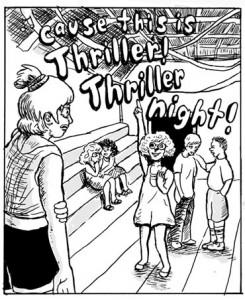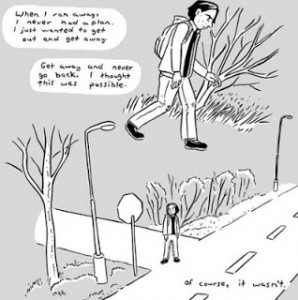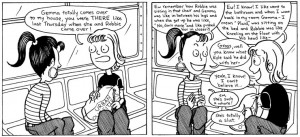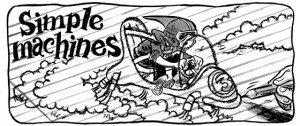Welcome to Using Graphic Novels in Education, an ongoing feature from CBLDF that is designed to allay confusion around the content of graphic novels and to help parents and teachers raise readers. In this column, we examine graphic novels, including those that have been targeted by censors, and provide teaching and discussion suggestions for the use of such books in classrooms.
IF you can survive junior high, you can survive ANYTHING!! (I Swear)
–Jace Smith, “Tips for Surviving Middle School,” Stuck in the Middle

The themes covered in this collection are about the awkwardness of coming-of-age, budding issues of sexuality, bullying, friendship (rife with loyalty and betrayal), loneliness, balancing one’s burgeoning sense of identity with the need of fitting in, and finding the courage to pursue passions when they may not make you popular. The book doesn’t pander to its audience and is frank in its depiction of middle school, which has resulted in library challenges. (For example, the Dixfield, Maine, school system received a complaint objecting to language, sexual content, and drug references in the book. The book was ultimately retained, but with restrictions.)
Note that as these comics are quite honest reflections of the trails and tribulations faced in middle school, many of the stories deal with delicate and possibly uncomfortable issues of sex, zits, smoking, drugs, and menstruation. Teachers and parents should use their discretion recommending this book. That said, it is wonderfully validating and honest and serves as a superb vehicle to talk about the tumultuous teens.
Alongside the collection of stories and themes is a wide range of drawing styles and ayouts. This adds to the sense of collage and reflection and serves as an opportunity to discuss themes of visual literacy, such as artistic style (from intricate woodcuts to simple sketches), use of positive and negative space, choice of line and texture, perspective, font selection and readability, and the pairing of image and language to relay a story.
Overview
The noted cartoonists contributing the seventeen short pieces include:
- “BFF,” by Vanessa Davis is about two teenagers are “Kinda like sisters” doing everything together and sharing their innermost passions and secrets, until they like the same guy.
- “Fair Weather” by Joe Matt is about a teenage boy has to deal with ramifications of acting like a jerk as his Mom fights back. This is one of the more unsettled vignettes. We are not sure why he acts this way (Is it hormonal?) or how his mother’s responses will affect or modify his behavior. It begs detail and resolution, which could fuel class discussions or written assignments.
- “Snitch” by Tania Schrag is about a teenage girl who has to decide how to handle classroom bullying with a teacher who isn’t as sensitive as he should be. As a result, a student’s quietly asking for some adult assistance inadvertently turns into a “snitch,” and it snowballs from there.
- “Anxiety” by Eric Enright is about a teenager who learns how to recognize and deal with school and the anxiety it creates within him. The simple art belies the complexity of this theme.
- “Plan of the Number 7 Bus,” by Ariel Schrag is about two catty girls who are so busy bad-mouthing others that they lose track of where and when to get off the bus. As a result, they find themselves in the bad part of town and one girl prays to God, making a deal: Get me out of this and I’ll be a better, kinder person. Will she? That makes for interesting class/book club discussion.
- “Tips for Surviving Middle School” by Jace Smith provides various strategies for coping with middle school. Smith promises that if you can tweak and follow the strategies provided and survive middle school, you’ll be able to survive anything.
- “Like a Weed, Joe” by Daniel Clowes is about a teenage boy who reflects upon being stuck at his grandparents’ cottage for the summer and must deal with loneliness and longing for love. He also has to deal with the influence of his only summer “friend”: an older boy whose influence may not be a positive one.
- “Tina Roti” by Cole Johnson is about a teenage girl who has to move out of her home because of her parents’ divorce as she befriends the teenage boy who moves into that home.
- “The Adventures of Batboy and Starling” by Nick Eliopulos is about a batboy who must cope with bullying and humiliation for team members. The team mascot tries to help him, but we later learn this was no help at all.
- “Hit Me” by Gabrielle Bell is about a teenage girl who wears the same clothes every day and earns the label “Stinky.” She and her brother try bum rides to school each day, and she is the victim of a lot of bullying. Finally facing one bully in particular, she eventually finds her way.
- “Crater Face” by Dash Shaw is about a teenage boy who wonders if he’ll aver find love with a face full of zits.
- “Horse Camp” by Lauren Weinstein is about a teenage girl’s misguided parents who send her to the Y sports camp to ride horses because she likes to draw (horses). The girl hates sports, and faced with freakish rain, must adjust to grooming her horse and playing indoor sports. And to top it off, our hero — who already feels desperately out of place — gets her period for the first time.
- “A Relationship in Eight Pages” by Jim Hoover is about a teenage boy who lucks goes in and out of teen love in eight pages.
- “Never Go Home” by Robyn Chapman is about a boy who can’t deal with his abusive, drinking father. After one last incident, the boy runs out of house and heads to school only to find there’s a school dance. He doesn’t dance so he decides to wait the night out under the bleachers. To his dismay, a girl seems to have the same idea and both end up finding some solace at the school dance.
- “The Disco Prairie Rebellion of ’81” by Ariel Bordeaux is about a teenage girl who struggles to find her own fashion statement at the risk of alienation and popularity.
-
“Simple Machines” by Aaron Renier is about a teenage boy with ADD who simply wants to get by in class and be left alone to his doodles and drawings.Some well-meaning classmates have their own ideas and comments about his drawings. While the teen tries to ignore them, he not only finds that he can’t ignore them but learns that those comments and ideas can help him find his place and his voice among them.
- “Shit” by Ariel Scharg is about a girl who is so embarrassed and socially awkward, she goes to extremes to avoid certain embarrassing bodily functions.
DISCUSSION SUGGESTIONS
Plot, Theme, and Character Development
- Have students create a visual map of each story’s underlying themes. Discuss how the stories themes relate / interact to each other.
- As there are seventeen short stories, assign one story each to a small group or to individual students. Have them analyze the character and plot of that story and either resolve it or further develop it.
- In “Anxiety,” Eric Enright tells the story of sixth-grader Terry, who through a therapist learns to recognize how and why school is causing such anxiety. Discus the physical signs Terry uses to recognize the anxiety and problem-solve how Terry can resolve some of the anxiety. You may want to extend the discussion to how different people exhibit anxiety and why.
- In “Plan of the Number 7 Bus,” Ariel Schrag tells the story of two girls who are on a bus and gossip the entire ride to find, missing their stop and finding themselves at the end of the bus line in a bad neighborhood. One girl prays to God, saying if God helps her, she’ll stop being mean. Discuss and evaluate the role of prayer and the power of belief.
Critical Reading and Making Inferences
- In “Fair Weather,” Joe Matt relays a very opinionated character in Joe. Discuss some of Joe’s statements:
- “Teams suck! All those extra people — who needs ‘em? They’re just in the way. I don’t wanna have to count on other people to win.” (p. 11)
- What if you totally suck at something and you need other people’s help to get better? If you suck at something, you shouldn’t do it.” (p. 11)
- In “Tips for Surviving Middle School,” Jace Smith provides a number of suggestions. Evaluate the effectiveness of these strategies, both for the characters in the comic and real-life scenarios in your school.
- Discuss the choice of title for “Like a Weed, Joe” by Daniel Clowes. Discuss the imagery and inferences it relays and its effectiveness as a title.
Language, Literature, and Language Usage
- Search for and discuss the use of imagery, simile, metaphor and puns throughout these comics.
- Have students select one of the seventeen vignettes and continue writing the story, using the original character’s voice. (Note: This will entail both understanding the language rhythm and word choices, as well as recognizing the underlying theme and understanding each of the story’s characters.)
- In “Tips for Surviving Middle School,” Jace Smith provides a number of tips. Evaluate the names of these tips and how they do and do not effectively relate to the strategies involved (i.e. “the forcefield technique,” “the laying it on the line method,” etc.). Then have students come up with their own strategies and catchy titles.
- Discuss the effectiveness of the titles of each of the seventeen comics and whether students may prefer different titles and why.
Modes of Storytelling and Visual Literacy
- Compare the depth and detail of these short stories with other coming-of-age books. Discuss the pros and cons of short versus novel.
- Analyze and compare the different drawing techniques found in these comics. Discuss how they influence the telling of the story and the feel it gives to the characters.
-
In “BFF,” Vanessa Davis does not use conventional panels. Evaluate and discuss how she uses the page to tell the story. Discuss is this made reading the comic easier or more difficult and why.
Suggested Prose and Graphic Novel Pairings
For greater discussion on literary style and/or content here are some prose novels and poetry you may want to read with Stuck in the Middle
- Smile by Raina Telgemeier — a fictional story about high school, friendships, and finding one’s voice.
- Be Confident in Who You Are by Annie Fox — a graphic novel that offers advice on common middle school concerns and practical advice for being healthy and for staying in control of your feelings and actions.
- American Born Chinese – about school, bullying, being different, and finding one’s voice.
- Nothing Can Possibly Go Wrong by Prudence Shen and Faith Erin Hicks — for high school and older about bullying, high school and love.
- Friends with Boys by Faith Erin Hicks — for high school readers about missing mothers, distant brothers, high school and new friends.
- The Absolutely True Diary of a Part-Time Indian by Sherman Alexie — about being different and surviving in school.
- Wonder by R.J. Palacio — about a boy who enters middle school after being homeschooled and who is bullied because of a facial deformity.
- Schooled by Gordon Korman – provides humor and strategies about bullying and finding your own voice.
- Stargirl by Jerry Spinelli — about the impact of peer pressure and bullying on the new and different girl (Stargirl) and on Leo, the narrator, who wrestles with the peer pressure surrounding him.
Common Core State Standards (CCSS)
While this book has a middle school reading level, its content may not be appropriate for all middle-grade students, and as such is recommended for mature middle school students and older. This, in turn makes it more challenging to use in classrooms. There are no doubt, classrooms that will be well-served with the content, language and structure of these comics, and I will be using the Common Core Anchor Standards for College and Career Readiness for Reading, Writing, and Speaking and Listening to help guide interested educators:
- Knowledge of Language: Apply knowledge of language to understand how language functions in different contexts, to make effective choices for meaning or style, to comprehend more fully when reading or listening.
- CCSS.ELA-Literacy.CCRA.L.3
- Vocabulary Acquisition and Use: Determine or clarify the meaning of unknown and multiple-meaning words and phrases by using context clues, analyzing meaningful word parts, and consulting general and specialized reference materials; demonstrate understanding of figurative language, word relationships, and nuances in word meaning; acquire and use accurately a range of general academic and domain-specific words and phrases sufficient for reading, writing, speaking and listening at the college and career readiness level.
- CCSS.ELA-Literacy.CCRA.L.4
- CCSS.ELA-Literacy.CCRA.L.5
- CCSS.ELA-Lieteracy.CCRA.L.6
- Key ideas and details: Reading closely to determine what the texts says explicitly and making logical inferences from it; citing specific textual evidence when writing or speaking to support conclusions drawn from the text; determining central ideas or themes and analyzing their development; summarizing the key supporting details and ideas; analyzing how and why individuals, events, or ideas develop and interact over the course of the text.
- CCSS.ELA-Literacy.CCRA.R.1
- CCSS.ELA-Literacy.CCRA.R.2
- CCSS.ELA-Literacy.CCRA.R.3
- Craft and structure: Interpreting words and phrases as they are used in a text, including determining technical, connotative, and figurative meanings and analyzing how specific word choices shape meaning or tone; analyzing the structure of texts, including how specific sentences, paragraphs and larger portions of the text relate to each other and the whole; Assessing how point of view or purpose shapes the content and style of a text.
- CCSS.ELA-Literacy.CCRA.R.4
- CCSS.ELA-Literacy.CCRA.R.5
- CCSS.ELA-Literacy.CCRA.R.6
- Integration of knowledge and ideas: Integrate and evaluate content presented in diverse media and formats, including visually…as well as in words; delineate and evaluate the argument and specific claims in a text, including the validity of the reasoning as well as the relevance and sufficiency of the evidence; analyze how two or more texts address similar themes or topics in order to build knowledge or to compare the approaches the authors take
- CCSS.ELA-Literacy.CCRA.R.7
- CCSS.ELA-Literacy.CCRA.R.8
- CCSS.ELA-Literacy.CCRA.R.9
- Range of reading and level of text complexity: Read and comprehend complex literary and informational texts independently and proficiently
- CCSS.ELA-Literacy.CCRA.R.10
- Comprehension and collaboration: Prepare for and participate effectively in a range of conversations and collaborations with diverse partners, building on others’ ideas and expressing their own clearly and persuasively; integrate and evaluate information presented in diverse media and formats, including visually, quantitatively and orally; evaluate a speaker’s point of view, reasoning, and use of evidence and rhetoric.
- CCSS.ELA-Literacy.CCRA.SL.1
- CCSS.ELA-Literacy.CCRA.SL.2
- CCSS.ELA-Literacy.CCRA.SL.3
Meryl Jaffe, PhD teaches visual literacy and critical reading at Johns Hopkins University Center for Talented Youth Online Division and is the author of Raising a Reader! and Using Content-Area Graphic Texts for Learning. She used to encourage the “classics” to the exclusion comics, but with her kids’ intervention, Meryl has become an avid graphic novel fan. She now incorporates them in her work, believing that the educational process must reflect the imagination and intellectual flexibility it hopes to nurture. In this monthly feature, Meryl and CBLDF hope to empower educators and encourage an ongoing dialogue promoting kids’ right to read while utilizing the rich educational opportunities graphic novels have to offer. Please continue the dialogue with your own comments, teaching, reading, or discussion ideas at [email protected] and please visit Dr. Jaffe at http://www.departingthe text.blogspot.com.
We need your help to keep fighting for the right to read! Help support CBLDF’s important First Amendment work by visiting the Rewards Zone, making a donation, or becoming a member of CBLDF!
All images (c) their respective creators.








